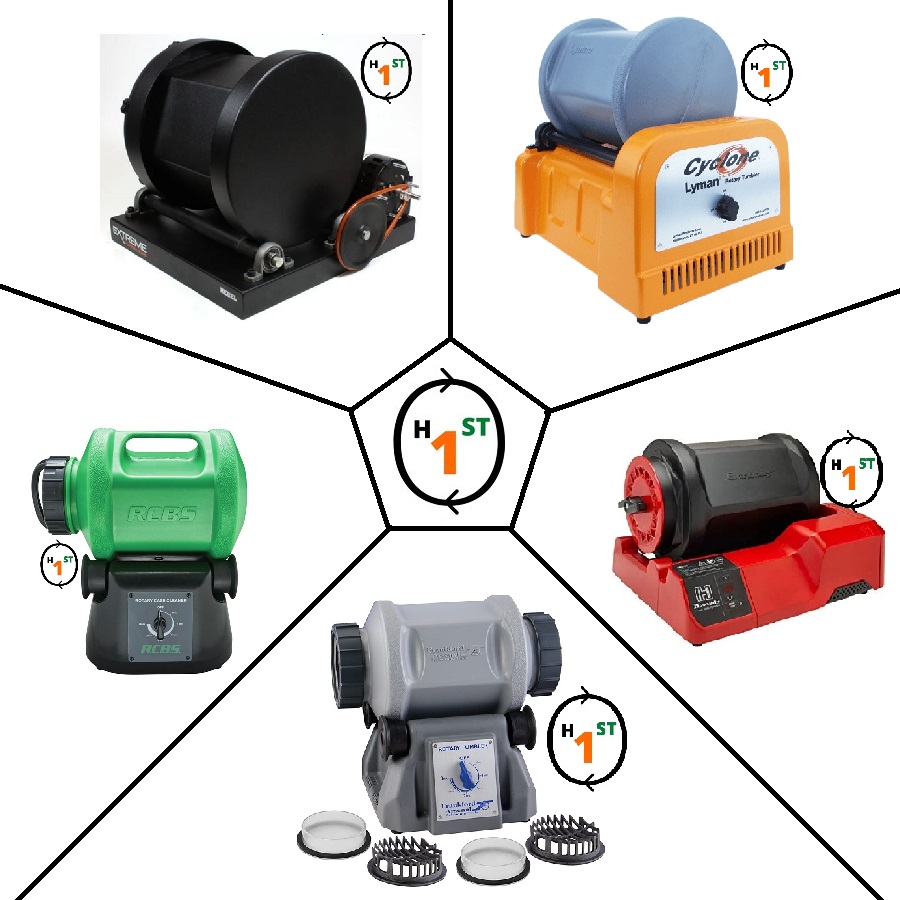Since you are here, I will assume you want your used cases to shine again after the shooting. This article puts ultrasonic vs rotary vs vibratory tumbler in an open field for comparison.
Well, 1st you must consider the budget because the price of dry tumblers starts at $60 whereas wet tumblers will begin at around $160. But the price is justified and in this guide, you will find out how each performs for a given set of rules.
We will look into all 3 types of brass case tumblers. Reveal our methodology of testing the tumblers and disclose the results, trying not to be biased. Though they all are made for the same purpose, the performance can vary for each type.
Ground Rules.
Let us begin with the methodology of the test. First, we will set some checkpoints and observe how each type of tumbler performs.
Rules
- Must be a good clean, Should remove most (visual) dirt, rust, and burnt gunpowder residue.
- Inside, outside & flash hole cleaning.
- Cost and longevity of the media.
- Level of difficulty in separating the cleaning media & the cleaned cases.
- Other steps, that may be necessary before the cases are ready to reload.
The ground rules are also numbered in their priority, which means even if separating the media after cleaning is easy but the cleaning is not great, we rank that type of brass tumbler down.
Before we proceed, let me 1st present a brief introduction to the types of brass tumblers and their media.
There are 3 types of brass tumblers.
- Vibratory Case Tumblers
- Rotary Case Tumblers
- Ultrasonic Case Tumblers.
First contender Vibratory Tumblers.
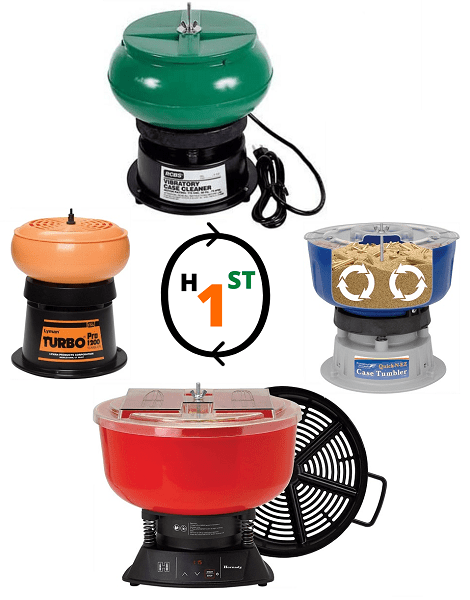
This is the first type of tumbler to hit the market for case cleaning, and like the name suggests it cleans cases by utilizing vibration. This is also the most popular brass cleaning method used because it is the most cost-efficient. Basically, there is a plastic or steel tub on top of a motor, and when the motor is turned on it vibrates whatever is inside the tub.
To begin case cleaning you require 2 (or 3) things.
- Dry media (Crushed Corn Cob or Crushed Walnut Shell)
- Used dirty cases
- Polishing agent (if needed)
The cleaning process involves placing dry media tumblers and dirty cases in the tub and a polishing agent to bring the shine back to the cases (optional). The motor underneath vibrates the tub vigorously creating friction between the media and casing to perform cleaning & polishing, inside and outside. But not so effective with the primer pocket (flash hole). Vibratory Tumbler can use 2 different types of dry media.
1. Crushed Corn Cob
The crushed corn cob is used when the cases are not too dirty, the toughness is just enough to remove dirt without damaging the brass casing. Ground corn cob can be bought fresh or mixed with a polishing compound. Corn Cob can also be used in rotary tumblers and usually has a better result than vibratory cleaning (only on the outside).

2. Crushed Walnut Shell
The crushed walnut shell is used for cleaning cartridges that are really dirty or rusted. Crushed walnut just like corn cob is environmentally friendly (i.e. if you are looking for a green solution). It comes in both untreated & treated (mixed with a polishing compound).

Lifetime of medias
The lifetime of these media can vary according to use. They usually lose their roughness on multiple-use and leave fine sticky dust that is harder to clean. The rule of thumb for replacement would be the time it takes to clean the cases. If the time to clean the cases using the media doubles or triples then it would take initially, then it is a good time to change the media.
Polishing Compound
It is always better to know which compound is used in the treated media if you are buying the treated media. Because some polishing compounds can leave color residue after polishing. Red Rouge for example leaves a subtle red hue on the brasses if the polishing compound is used excessively.
Next up Rotary Tumblers.
This type of case tumbler is like a front-loading washing machine for your brass cases. This technology is relatively new when compared to the vibratory type. This was designed to use stainless steel pins, with water and a little bit of cleaning solution but you can use the vibratory media (without water of course) as well.
To begin case cleaning you will require:
- Stainless steel media
- Dirty brass cases
- Polishing solution (could be any mild citric acid, soap, or “Lemi Shine”).
- Water.
You begin by dumping the dirt brass in the container, along with stainless steel pins, water, and cleaning solution. Keep in mind not to exceed 3/4th of the container, as a fully loaded container will have little to no tumbling effecting hence hardly any cleaning takes place.
The stainless still pins are capable of cleaning and removing the rust, inside, outside, and in the flash hole. The pins are also a one-time investment and can be used continuously without the need to replace them unless you lose them in the sink.

To polish your brass cases just add a little bit of the polishing solution you want to use (soap or Lemi shine – your decision). The job of the polishing solution is to remove the dirt that gets stuck with the case due to lube applied during the previous reloading.
Warning, use the polishing solution in a very small quantity. Because the polishing solution is either an acid or alkali, and both of them dissolve zink in the brass leaving only copper and hence reducing the durability and lifetime of the cases. How much to use? A good ratio of water to polishing agent would be instructed on the cleaning solution’s label but if it is not I suggest 40:1, this is just the starting point and you should find your own perfect ratio.
Lastly, Ultrasonic Tumblers.
This type of brass case tumbler is the latest technology. It uses ultrasonic sound waves to vibrate the water molecules and with the help of liquid soap or other cleaning solution, it cleans the cases.
You will require the following to begin case cleaning:
- Liquid soap or cleaning solution.
- Dirty brass Cases
- & Water
Begin by pouring water in the ultrasonic tumbler, mixing the water with liquid soap or “Lemi Shine” and turning the heat function “on” in the ultrasonic tumbler. After heating to an appropriate temperature, add the dirty cases to the ultrasonic tumbler and turn on the cleaning function for 20 – 30 minutes as you see fit.
You do not require any media because here the water becomes the media as ultrasonic sound waves are beamed through them. And since it is ultrasonic it is practically noiseless. On top of that, you can also clean gun parts if they fit into your ultrasonic cleaner.
So with the introduction out of the way let’s disclose how they perform against each other in a controlled experiment following the rule checks.
Effective Cleaning
One may ask – why do we need to clean? We reloaders clean them to avoid damaging the reloading dies, and gun barrel & increase the number of times a brass case can be recycled. The presence of dirt, rust, or burnt gunpowder residue can easily damage the dies while sizing or bullet seating. It may also damage the gun barrel while shooting and at times even jam the gun and the brass case can be also damaged which reduces the number of times any case can be recycled.
We are performing these time-consuming tasks so that we have clean and shiny brass to begin reloading. It is more like performing maintenance to increase longevity and increase cost-efficiency.

Here is a sample of cases that were used for testing the effective cleaning of the brass cases. On the right of the pictures, are fresh bullets before shooting them on the range. On the left are pictures of once-fired cases with the suppressor. I used about 20 deprimed cases for this experiment. The result is given below.
Comparison of effective cleaning of tumblers
| Vibratory Tumbler | 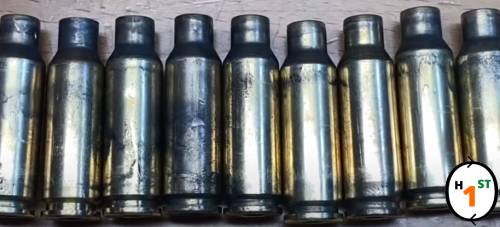 |
| Rotary Tumblers |  |
| Ultrasonic Tumblers |  |
The pictures above show results after 1 hour of tumbling action. And the results are clear that Rotary Tumblers clean the best.
Usually, Ultrasonic Tumblers give better results than shown here in the picture. Maybe the amount of “Lemi Shine” I used was not adequate.
Cleaning the Flash Hole & Primer Pocket.
The flash hole & primer pocket are the toughest to clean as it has tiny spaces but a vital point. And it might surprise you, that not all tumblers can reach these places. The flash hole & primer pocket needs to be clean and maintained in perfect shape. Several things can go wrong due to a deformed Primer Pocket.
- While seating primer it can burst due to pressure (i.e. why you should always prime pointing away from any body parts).
- It can end up protruding from the case and can jam the gun in the chamber.
| Vibratory Tumblers |  |
| Rotary Tumblers | 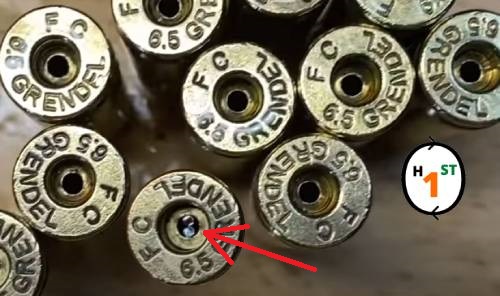 |
| Ultrasonic Tumblers | 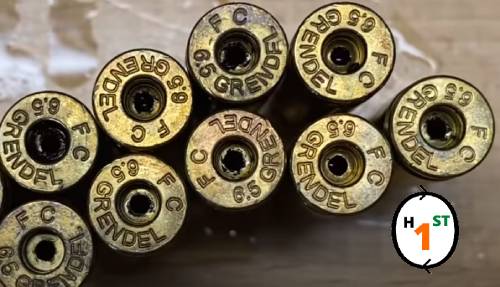 |
The effective cleaning for the flash hole is shown in the pictures above & the results for the vibratory tumbler are the worst, it is almost as if no cleaning took place there. On top of that, I had to poke and remove the media that were stuck in the flash hole.
The Ultrasonic Tumblers did a better job at cleaning this tough spot but keep in mind the results could have been better due to not adequate cleaning solution the results are not the best they usually give.
The Rotary Tumbler had the best results when cleaning the flash hole & the primer pocket. But had a few stuck stainless steel pins in the flash hole.
In summary, the flash hole is best cleaned by rotary tumblers followed by ultrasonic tumblers. And let us leave vibratory tumblers out of this comparison because in my Honest Opinion it would be an insult to other types of brass case tumblers.
The Insides of the Case
The insides of a brass case need to be clean as well because unclean brass can affect the burning rate of the gunpowder and affect pressure buildup inside the brass case, ultimately resulting in a slower velocity than expected.
The insides of a case are harder to take pictures of. And in this test as well the rotary tumbler cleans the best, in the second position, the ultrasonic and vibratory do the least effective job.
Cleaning Media and its Reusability
I have already touched on this topic above for vibratory, rotary, and ultrasonic tumblers. And would just summarize that in this section.
Crushed Corn Cob – good for mild dirty cases, gets used up and needs to be replaced over time hence cost builds over time.
Crushed Walnut shell – Good for extremely dirty cases, gets used up and needs to be replaced over time. Hence cost builds over time.
Stainless Steel Pins – Good for all types of cases and can be reused indefinitely.
Polishing Agents – Polishing agents are all the same and require regular replacement as they get used up. One cheap option is “Lemi Shine“.
Cleaning Time
Here we discuss how long it takes to clean the cases because some can take as long as 8 hours and still have not satisfactory results. Whereas some ultrasonic cleaners can get the job done in just 30 minutes and rotary tumblers can take about 2 to 3 hours.
Level of Difficulty in Separating the Cases and Media
Here we will compare how hard it is to separate the cleaned cases from the media.
For Vibratory Tumblers separating is quite easy if you have a shifter, Just lift the tub, pour the content through the shifter and let the shifter do its job in separating the cases from the media. The problem with this method is the flying dust particles, which are very unhealthy and easily stick with other objects in the immediate vicinity.
For Rotary Tumblers separating the media requires two shifters, one to catch the cases and the second to catch the steel pins and it requires some strength as the container becomes heavy when you have about 800 cases, steel pins, and water in the container
For Ultrasonic Tumblers, it is the easiest it just lifts the cases and is done. By far this is the easiest way to separate cases from media.
In short, Ultrasonic is the easiest, Vibratory is the medium, and Rotary is the hardest. But for Ultrasonic and Rotary tumblers one extra step includes drying the cases.
Other Necessary Steps to Begin Reloading.
All tumblers require 1 or 2 extra steps (besides visual inspection) before you can take the cases and begin reloading.
Vibratory tumblers as shown above do not clean the primer pocket that well hence you need to clean them separately (time-consuming).
Both Rotary and Ultrasonic Tumblers use water and hence you will need to dry the cases before begin reloading. The cheap way is to lay the cases in direct sunlight some manufacturers make equipment to dry the cases inside as well (check here).
Overall Cost
The overall cost can be hard to evaluate as there are many factors but we will try to evaluate nonetheless. For the sake of calculations, I will assume that we will we are going to operate the tumblers continuously for 2 months (61 days). One more thing I’ll not disclose the tumblers I used for this evaluation.
| Description | Vibratory Tumblers | Rotary Tumblers | Ultrasonic Tumblers |
|---|---|---|---|
| Initial Cost | Low Cost = $65 | Medium Cost = $160 | Medium Cost =$195 |
| Cost of Media | Requires Replacement $20*5 = $100 | One time investment $60 | None required |
| Polishing Agent | Low cost = $22 | Very Cheap = $4 | Very Cheap = $4 |
| Time required for 2 months – Electricity cost | 8 hours = 17.87 cent $10.9 for 2 months | 2 & half hours = 4.38 cents, $2.67 for 2months | Half Hour = 3.2 Cents $2 for 2 months |
| Other equipment needed | Shifter = $8 | Shifter and Dryer = $35 + $100 = $135 | Dryer = $100 |
| Total Cost | $205.9 | $363.38 | $302.2 |
As some may say Quality comes at a Price, which is true in this sector. Because we have seen that The rotary tumblers are the best at cleaning but also the most expensive. The ultrasonic gives satisfactory results but to let you know I have chosen a 6L tank and the price varies with the size of the tank.
As for the vibratory tumbler, the cost increases as you will have to replenish the media over time, and becomes more expensive than the other types of brass case tumblers.
Ultrasonic vs Rotary vs Vibratory Tumbler – and the Winner?
We had a detailed review of all types of tumblers and here I will summarize them and announce the winner.
The Vibratory Tumbler
| Pros |
|---|
| Small Initial Cost |
| Many types of Media to choose from |
| Requires less effort in media separation |
| Cons |
|---|
| The cleaning is not satisfactory |
| The primer pocket is never cleaned |
| Occasionally media get stuck in the flash hole. |
| Can’t remove rust or heavy tarnish |
| Generates unbearable noise |
| Produces Lead Dust |
| Cost racks up with media replacement. |
The initial cost is low but the need for media replacement soon catches up with the price of a rotary tumbler. It produces lead dust which is highly poisonous when inhaled.
The Rotary Tumblers
| Pros |
|---|
| Excellent cleaning |
| Saves financially in the long run |
| Removed lead dust is dissolved in water hence easier to dispose of. |
| Removes rust and heavy tarnish |
| Cons |
|---|
| High Initial Cost |
| Media Separation requires effort |
| The cases need rinsing to remove soap water |
| Media may occasionally get stuck in the flash hole |
| Little noisy |
| Requires drying before reloading |
The rotary tumbler is an excellent brass cleaner that reaches the tough spots and cleans them. It has a high initial cost, but in the long run, it is financially more efficient. Read the rotary tumbler comparison to find out more about it.
The Ultrasonic Tumbler
| Pros |
|---|
| Noiseless |
| Performs satisfactory cleaning |
| Case removal is the simplest |
| Cheapest in terms of electricity cost |
| Requires the least amount of time |
| Easy disposal of lead contaminant |
| Cons |
|---|
| High initial cost |
| Cases require rinsing to remove soap water |
| Cases require drying before reloading |
If noise is an issue definitely go with the Ultrasonic Tumblers as they are almost noiseless. The cleaning is satisfactory and it costs less than rotary tumblers. And if you have decided to go with ultrasonic tumblers let me help you in narrowing down the choices.
Conclusion
Rotary tumblers are hands down the best but are a little noisy even with the rubber coating Frankford Arsenal applies but it is bearable and expensive. The ultrasonic tumblers cost a little less at the same time being noiseless and satisfactory cleaning.
But if the initial high cost is a major issue then going for vibratory tumblers is preferable but I suggest thinking again before making the final decision. In this head-to-head comparison of ultrasonic vs rotary vs vibratory tumbler, I believe rotary takes the spot with ultrasonic falling short by a tiny bit. And with the growing technology, it may not be surprising if in the future I recommend ultrasonic instead of rotary tumblers.

